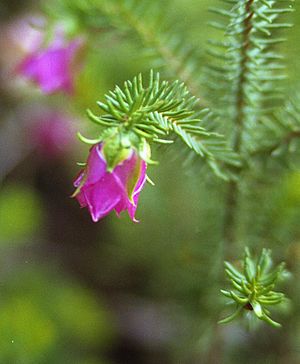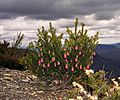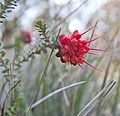Darwinia (plant) facts for kids
Quick facts for kids Darwinia |
|
|---|---|
 |
|
| Darwinia leiostyla | |
| Scientific classification |
|
| Kingdom: | Plantae |
| Clade: | Tracheophytes |
| Clade: | Angiosperms |
| Clade: | Eudicots |
| Clade: | Rosids |
| Order: | Myrtales |
| Family: | Myrtaceae |
| Subfamily: | Myrtoideae |
| Tribe: | Chamelaucieae |
| Genus: | Darwinia Rudge |
| Species | |
|
See text |
|
Darwinia, also called mountain bells or just bells, is a group of about 70 types of evergreen shrubs. These plants belong to the Myrtaceae family, which also includes eucalyptus trees. They are found only in Australia, mostly in southern Western Australia. A few species also grow in South Australia, New South Wales, and Victoria.
The genus was named in 1816 by Edward Rudge. He named it after Erasmus Darwin, who was the grandfather of the famous scientist Charles Darwin. Most Darwinia plants grow between 0.2 and 3 meters (about 0.7 to 10 feet) tall. Some types even grow flat along the ground. They usually have small, simple leaves. Their flowers often grow in groups. Each flower has five red, white, or greenish petals and ten stamens (the parts that make pollen). Many Darwinia flowers are surrounded by large, colorful leaf-like structures called bracts. These bracts are what give them their common names like "mountain bells."
Contents
What Darwinia Plants Look Like
Darwinia plants are woody shrubs that can be low-growing or stand upright. They usually grow from 0.2 to 3 meters (about 0.7 to 10 feet) tall. Their leaves are often arranged in pairs opposite each other. The leaves are simple, small, and can be needle-like or oval-shaped. They also contain special essential oils.
The flowers grow near the ends of the branches. They are usually surrounded by green, leaf-like bracts. There are also larger, often colorful bracteoles (smaller bracts). Each flower has five very small sepals and five petals. These petals cover the stamens. The petals can be white or other colors. Inside the flower, there are 10 stamens and 10 staminodes (parts that look like stamens but don't make pollen). These are hidden by the petals. A long part called the style sticks out from the flower. It has a group of hairs near the stigma, which collects pollen. The fruit is a dry nut that usually holds one seed when it's ripe.
How Darwinia Got Its Name
The group of plants called Darwinia was first officially described by Edward Rudge in 1816. He wrote about it in a scientific paper called Transactions of the Linnean Society of London. The first type of Darwinia plant described was Darwinia fascicularis.
There are about 70 known species of Darwinia. However, many of them have not yet been officially named and described by scientists. In 1865, George Bentham studied the genus and described 23 species in his book Flora Australiensis. The genus was named after Erasmus Darwin, a well-known doctor and naturalist.
About 30 Darwinia species have been found but not yet formally named. They are given informal names, like Darwinia sp. Bindoon or Darwinia sp. Canna.
Where Darwinia Plants Grow
Darwinia plants are found in several parts of Australia. These include New South Wales, Victoria, South Australia, and Western Australia. Most of the species, about 60 out of 70, grow in Western Australia. The other 11 species grow naturally in New South Wales.
Challenges for Darwinia Plants
Many areas where Darwinia species naturally grow have been reduced. This is due to land being cleared for farms or buildings, and also from animals grazing. It is hard for these plants to recover because of dry weather (droughts). Changes in how often fires happen also affect them. Some species, like Gillam's Bell (Darwinia oxylepis), are also at risk from a plant disease. This disease is caused by a tiny organism called Phytophthora cinnamomi.
Protecting Darwinia Species
Some Darwinia species are in danger of disappearing forever. They are listed as Endangered or Vulnerable on Australia's National List of Threatened Flora. This means they need special protection. Examples of these at-risk species include the Yellow Mountain Bell (Darwinia collina), Gillam's Bell (Darwinia oxylepis), and Abba Bell (Darwinia whicherensis).
Growing Darwinia Plants
It can be tricky to grow Darwinia plants from seeds. However, they can be grown from cuttings. This means taking a small piece of the plant and helping it grow roots.
List of Darwinia Species
Here is a list of Darwinia species that are recognized by the Australian Plant Census as of December 2020:
- Darwinia acerosa – fine-leaved darwinia (endangered)
- Darwinia apiculata – scarp darwinia (endangered)
- Darwinia biflora (vulnerable)
- Darwinia briggsiae
- Darwinia camptostylis - clustered darwinia
- Darwinia capitellata
- Darwinia carnea – Mogumber bell, Narrogin bell (endangered)
- Darwinia chapmaniana – Chapman's bell or Eganu bell (endangered)
- Darwinia citriodora – lemon-scented myrtle
- Darwinia collina – yellow mountain bell (endangered)
- Darwinia diminuta
- Darwinia diosmoides
- Darwinia divisa - (presumed extinct)
- Darwinia fascicularis
- Darwinia ferricola – Scott River darwinia (endangered)
- Darwinia foetida – Muchea bell
- Darwinia glaucophylla (threatened)
- Darwinia grandiflora
- Darwinia helichrysoides
- Darwinia hortiorum
- Darwinia hypericifolia
- Darwinia leiostyla
- Darwinia leptantha
- Darwinia luehmannii
- Darwinia macrostegia – Mondurup bell (vulnerable)
- Darwinia masonii – Mason's darwinia (vulnerable)
- Darwinia meeboldii – Cranbrook bell (vulnerable)
- Darwinia micropetala – small darwinia
- Darwinia neildiana – fringed bell
- Darwinia nubigena – success bell (vulnerable)
- Darwinia oederoides
- Darwinia oldfieldii
- Darwinia oxylepis – Gillam's bell (endangered)
- Darwinia pauciflora
- Darwinia peduncularis (vulnerable)
- Darwinia pimelioides
- Darwinia pinifolia
- Darwinia polycephala
- Darwinia polychroma – harlequin bell (endangered)
- Darwinia procera
- Darwinia purpurea – rose darwinia
- Darwinia salina
- Darwinia sanguinea
- Darwinia speciosa
- Darwinia squarrosa – pink mountain bell (vulnerable)
- Darwinia taxifolia
- Darwinia terricola
- Darwinia thymoides
- Darwinia vestita – pom-pom darwinia
- Darwinia virescens – Murchison darwinia
- Darwinia whicherensis – Abba bell (endangered)
- Darwinia wittwerorum – Wittwer's mountain bell (endangered)
Gallery
-
Darwinia chapmaniana in Kings Park
-
Darwinia grandiflora in Royal Botanic Gardens, Cranbourne
-
Darwinia leiostyla in the Stirling Range, Western Australia
See also
 In Spanish: Darwinia para niños
In Spanish: Darwinia para niños










